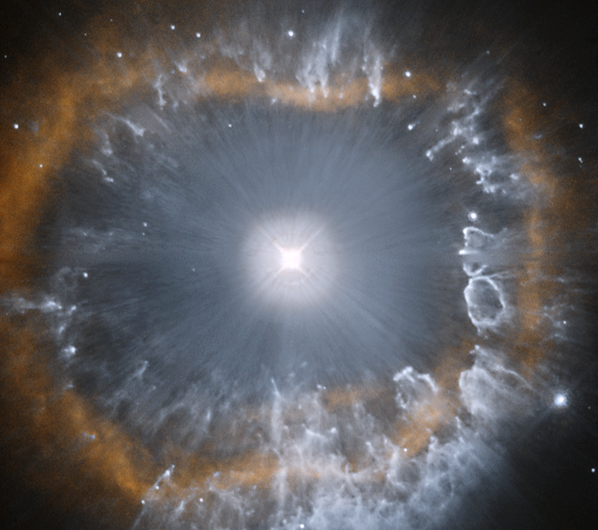October 25, 2016 weblog
Four luminous blue variables found to be much closer than previously assumed

(Phys.org)—A new study based on the first Gaia data release (DR1) reveals more accurate measurements of the distance of four canonical luminous blue variables (LBVs) in the Milky Way galaxy. According to a research paper published Oct. 20 on the arXiv server, they are much closer to Earth than previously thought.
Published on Sept. 14, 2016, DR1 contains a catalog of over 1 billion stars with precise measurements of their brightness and positions in the sky. These data were obtained by ESA's Gaia satellite, which is completing the first-ever "galactic census"—the most detailed three-dimensional map of the Milky Way ever made. The release of DR1 offers the scientific community an excellent opportunity to improve knowledge of our stellar environment and to redefine some previous calculations.
Combing through the data obtained by Gaia, Nathan Smith of the Steward Observatory in Arizona and Keivan Stassun of Vanderbilt University in Nashville, Tennessee, have searched for LBVs and LBV candidates. These massive evolved stars showcase unpredictable and sometimes dramatic variations in both their spectra and their brightness. Their strong mass loss is believed to play a critical role in the evolution of massive stars, however the exact role LBVs play and the physics of their instability are still uncertain.
Four canonical LBVs in the Milky Way were of special interest for Smith and Stassun, namely: AG Car, HR Car, HD 168607 and Hen 3-519 (an LBV candidate).
"Here, we report direct distances and space motions of four canonical Milky Way LBVs—AG Car, HR Car, HD 168607, and (the LBV candidate) Hen 3-519 – whose parallaxes and proper motions have been provided by the Gaia first data release," the researchers wrote in the paper.
The most important findings were made regarding the distance of these LBVs. The clue to understanding their peculiar instability is their high observed luminosity, which, in the case of those stars, often depends on an uncertain distance calculations.
According to the paper, the distance of HD 168607 was re-calculated from about 7,000 to 3,800 light years. Similar correction was made in the case of HR Car, as its distance from Earth, previously thought to be approximately 16,000 light years, also turned out to be only half of the value – about 7,500 light years.
The astronomers found more surprising results regarding AG Car and Hen 3-519. DR1 data reveal that AG Car is located just 6,400 light years away, replacing earlier calculations indicating a distance over a three times larger, approximately 21,500 light years.
Finally, the study finds that the distance of Hen 3-519 shows the biggest discrepancy between the previous and latest estimates. The new measurements reveal that its distance is 5,200 light years from the Earth, while the previously adopted distance was 26,000 light years.
"The distances to all four objects are closer than traditionally assumed in the literature, lowering their intrinsic luminosities," the paper reads.
The researchers noted that the lower luminosities suggest that AG Car and Hen 3-519 passed through a previous red supergiant phase. They also imply that binary evolution could explain their peculiar properties. Moreover, the scientists concluded that the new results may initiate a re-evaluation of our current understanding of LBVs.
"More precise values of the parallax for a larger number of Galactic LBVs will be available soon; the results reported here may signal upheaval in our understanding of massive star evolution, even if they are regarded as preliminary," the astronomers wrote.
More information: The canonical Luminous Blue Variable AG Car and its neighbor Hen 3-519 are much closer than previously assumed, arXiv:1610.06522 [astro-ph.SR] arxiv.org/abs/1610.06522
Abstract
The strong mass loss of Luminous Blue Variables (LBVs) is thought to play a critical role in the evolution of massive stars, but the physics of their instability and their place in the evolutionary sequence remains uncertain and debated. A key to understanding their peculiar instability is their high observed luminosity, which for Galactic LBVs often depends on an uncertain distance estimate. Here we report direct distances and space motions of four canonical Milky Way LBVs—-AG Car, HR Car, HD 168607, and (the LBV candidate) Hen 3-519—-whose parallaxes and proper motions have been provided by the Gaia first data release. Whereas the distances of HR Car and HD 168607 are consistent with those previously adopted in the literature within the uncertainty, we find that the distances to Hen 3-519 and AG Car, both at ∼2 kpc, are much closer than the 6—8 kpc distances previously assumed. For Hen 3-519, this moves the star far from the locus of LBVs on the HR Diagram. AG Car has been considered a defining example of a classical LBV, but its lower luminosity also moves it off the S~Dor instability strip. The lower luminosities allow AG Car and Hen 3-519 to have passed through a previous red supergiant phase, they lower the mass estimates for their shell nebulae, and imply that binary evolution is needed to account for their peculiar properties. These lower luminosities and initial masses for LBVs may also have important implications for understanding LBVs as potential supernova progenitors. Improved distances from next year's Gaia data release, which will include additional LBVs, may alter our traditional view of LBVs.
© 2016 Phys.org



















